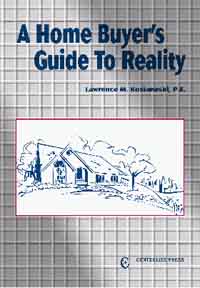
MAKIN' A LIST
CHECKIN' IT TWICE
edited excerpts from
"A Home Buyer's Guide To Reality"
by Lawrence M. Kostaneski, PE
Copyright 1998 Centerline Press
 |
MAKIN' A LIST
edited excerpts from "A Home Buyer's Guide To Reality" by Lawrence M. Kostaneski, PE Copyright 1998 Centerline Press |
This month will reveal ALL ! Well, not exactly. What I plan to do is take an edited version of the checklist included in the book, and present it as a reminder of the surprising number of problems a house can have: some that you wouldn't even notice unless you were actively looking for them.
The items of concern are grouped into categories that provide a systematic approach and avoid duplication of effort. As an example, before going to the trouble of finding out if a house is flood prone, you might decide that you don't want to live 2 miles downwind from a landfill anyway. Sad to say that most people don't do this exercise, and many of these end up very unhappy that they didn't.
The first category deals with the surrounding environment. This will vary with the density of development near the house that caught your eye. Where residential development is pushing outwards from the center of a community, it is not uncommon for the new development to "inherit" neighbors that are not necessarily desirable. Here is a list of some of them: Airports, Landfills, Waste Treatment Plants, Manufacturing or Industrial Facilities, Major Roads, Commercial Centers, Quarries, Asphalt Plants, Concrete Plants, undesirable neighborhoods.
Prevailing winds are a big part of the impact from some of these, traffic is another impact that you may not enjoy. Safety is yet another impact, particularly if the new development is close to areas that you are not comfortable with, or a nearby business attracts people who are not pleasant.
Housing developments can be very attractive: from the inside. But nearby, that may not be true. Put your "nose to the wind" and drive around to discover if any of these things are present.
The next category deals with the government regulatory environment. It is not uncommon for a government to annex property. When this happens, there can be a dramatic change in the rules you have to live by, or the amount of taxes you have to pay. Another set of regulations deal with the neighborhood. Your development may have covenants. Find out what they are before you start worrying about the size of the bedrooms. Here is a list of some of the items in this category: Annexation Potential, Covenant Restrictions, Deed or Plat Restrictions, Special Assessments.
The next category deals with those items that indirectly influence the house you are considering. Some of the more important things are: the activity and kinds of people in the neighborhood; traffic, streets and sidewalks; flooding history; environmental problems; the water and sewer systems serving the home; emergency services response patterns; zoning, and who pays for fixing the streets.
The final category deals with those items that directly influence the house. Some of the important ones are: the soil type; rainfall and snowmelt drainage patterns; foundations; bugs; encroachment by other buildings on the property, internal systems; structural problems, safety and security issues.
You may think this list is long. In fact, not everything is included. Why is it so long, you ask ? Because I have seen every one of these items cause a great deal of consternation among home owners. Some became serious confrontations between neighbors, or between the neighborhood and the local government, in some cases lasting almost two years before a compromise was reached.
There are hundreds of thousands of people across the country who have been caught up in one or more of these issues. (People who get caught up in more than two of these are particularly testy.)
Future articles will discuss the categories and specific items in more detail. I also plan to relate a few true stories to demonstrate how and why some of these items became such a dilemma for the buyers. A house with a problem is easy to buy, but extremely difficult to live with. Think about that when you decide that this is just too much time and effort to invest in that "Dream Home".
|
now or in the future? You can't afford to be without this book.
For only $17.95
Order now
A Resource for the Home Buyer A Must Have for the Buyer's Agent A Thoughtful Gift for the Kids. |
|
||||||||
Mr. Kostaneski is a registered Professional Engineer with over 20 years experience in the design and construction industry, 10 of those as a government regulatory official responsible for resolving residential development problems. He is owner of Centerline, an engineering consulting firm. Comments are edited excerpts from his book, "A Home Buyer's Guide To Reality".